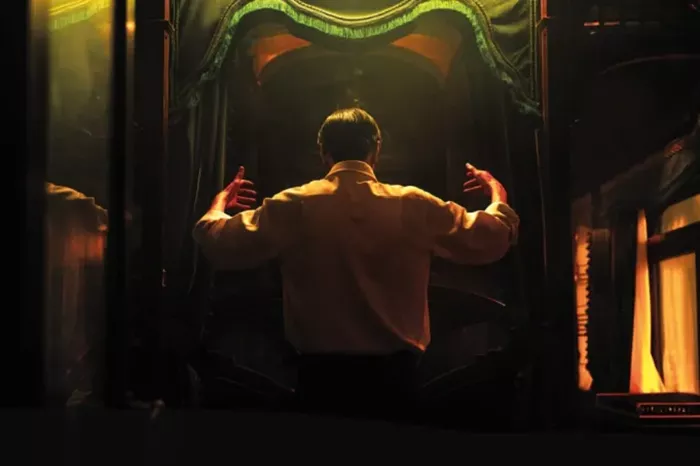Do you remember the days when we watched films with unreserved wonder, as if chasing a dream? Bi Gan, the Chinese director known for his 2018 film Long Day’s Journey Into Night, certainly does. Now, seven years later, his return—or “resurrection”—has arrived: an ambitiously opulent, highly intricate film that feels like five or six movies woven into one. Each segment is at once playful and surreal, composing a melancholic ode to the dreams of 20th-century cinema and the lives lived within them.
At its core, Resurrection presents a paradox: set in a near future (perhaps a reflection of our current post-pandemic era) where dreams and cinema have become indistinguishable—and where this fusion signals a troubling loss, as no one seems to dream anymore.
The film’s narrative framework unfolds through a silent-movie-style prologue, explaining a somewhat awkward yet whimsical sci-fi backdrop reminiscent of Stalker and Blade Runner. Humanity discovers that longevity depends on ceasing to dream—an extended metaphor central to the film. Like a candle that burns forever only if never lit, life is preserved by suppressing dreams. Yet, dissenters—called “Fantasmers”—choose instead to live brief, blazing lives. Co-written by Bi Gan and Bai Xue, these dreamers are portrayed as dangerous rebels who “disturb history” and “make time leap.” Opposing them are the “Big Others,” guardians tasked with distinguishing illusion from reality and hunting down Fantasmers hiding in the imagined worlds of cinema to preserve time’s linear flow.
From the outset, viewers are immersed in these nested dream stories, each representing a different cinematic era and engaging one of the five senses. The first segment, mimicking silent film and centered on vision, introduces the Fantasmer played by Yi Yangqianxi, who appears in five distinct incarnations. His pursuer, the Big Other, is portrayed by Shu Qi, radiant in a high-collared silk blouse of a distinctive shade Bi Gan once described as “Biggan Green” in his previous work.
This portion showcases the exquisite baroque set designs by Liu Qiang and Tu Nan. The Fantasmer is a quintessential movie monster, evoking Nosferatu meets Quasimodo, hiding within a lavish, toy-like model of a Chinese opium den, complete with stop-motion marionettes. Around the corner, the set transforms into a German Expressionist labyrinth of slanted angles and shadows, where Shu Qi dances like Moira Shearer in The Red Shoes. The mood is intensified by a love theme reminiscent of Vertigo or an opulent, chameleon-like score by M83, weaving obsession between the monster and the woman sent to kill him.
Though she ultimately captures him, as her voiceover reveals, she is moved by his devotion to a dreamlike existence. Unable to alter his fate, she wishes to ease his passing, opening his heart to let a projector revive the Fantasmer as a handsome young man.
This figure appears in a wartime espionage noir, complete with felt hats, train stations, and a mirror gunfight straight out of Shanghai Triad. Accused of stabbing a man’s ear with a pen—a role played by Yan Nan—he is murdered. While this sound-focused segment is arguably the least coherent, it’s elevated by striking imagery: floating musical scores, a bomb blasting through a station’s roof, bloodied hands playing a theremin.
Wax melts. The Big Other contemplates. Thirty years later, the Fantasmer reappears as a factory worker abandoned in a dilapidated Buddhist temple, encountering a bitter spirit lodged in his rotten tooth (played by Chen Yongzhong). This taste-themed tale resembles a Chinese folktale, featuring a cunning deity toying with a hapless victim. Two decades on, the Fantasmer becomes the prankster father of a young girl (Guo Mucheng), training her to fake supernatural powers by “smelling” the right card from a deck. Finally, on New Year’s Eve 1999, the Fantasmer is a blond, blue-eyed young hoodlum who has never kissed a girl, while the girl (Li Gengxi) wears half-moon sunglasses and high-top Converse, resembling a sultry figure from a 90s Wong Kar-wai film—someone who may have kissed many but never bitten anyone.
This 40-minute continuous shot sequence, featuring fights, gun battles, and a full karaoke session, may lack the ethereal, otherworldly 3D visuals of Long Day’s Journey Into Night, but it amazes in different ways: seamlessly entering characters’ subjective worlds before pulling back; Dong Jinsong’s camera elegantly freezing on a street party in time-lapse, with people moving in fast motion while a silent movie plays at normal speed in the background.
Aside from playful distortions of time and subjectivity—and the occasional briefcase—there is little narrative continuity between stories. Each, however, revolves around a form of pursuit—of a killer, enlightenment, a major crime, or a girl—all within the broader hunt by the Big Other for Fantasmers. Even in its most obscure moments, Resurrection reads as a prolonged chase, peppered with erudite references ranging from high art influences to a riddle whose answer is “fart.”
Bi Gan reimagined this film during the pandemic, a time when surreal, vivid dreams became widespread but faded as COVID-19 receded. Meanwhile, his beloved classic cinema faces challenges from new technologies and shifting viewing habits, as audiences find distractions amid chaos, and their capacity—or desire—for artistic immersion diminishes. In Bi Gan’s worldview, this is tragic, as the sensory illusions of film harbor ineffable beauty, and seeking refuge therein holds noble meaning—even if it means escaping reality, where things might be realized rather than just dreamed.
Ambitious and complex, Resurrection resists being a manifesto and will test viewers accustomed to straightforward narratives. Yet for those who long for cinema’s bygone power to move and astonish, it offers a vivid lesson in the paradoxical joy between immersion and surrender—a dazzling film-literature class on the lost art of letting go.
Related Topics
- Ethan Coen’s Go, Beavers! to Conclude Lesbian B-Movie Trilogy
- “University Bomber” True Story Now in Theaters
- Kamal Haasan’s Vaalivu Ulagam Draws Mixed Reviews

